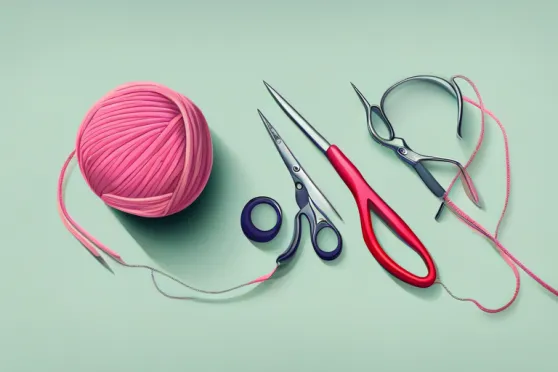導入
かぎ針編みは、心地よいブランケットからスタイリッシュなアクセサリーまで、さまざまな美しいアイテムを作ることができる、やりがいのある創造的な趣味です。この工芸を始めることに興味がある場合、どのような材料を購入すればよいかを知ることは大変なことです。このガイドは、かぎ針編みの旅を始めるために必要な基本的なツールと材料を見つけるのに役立ちます。
まったくの初心者でも、道具を新しくしたい場合でも、スムーズで楽しい体験をするには適切な道具を用意することが重要です。重要なアイテムには、かぎ針、毛糸、はさみ、ステッチマーカーなどがあり、それぞれがクラフトのプロセスで特定の目的を果たします。
高品質の材料に投資することは、かぎ針編みの体験を向上させるだけでなく、プロジェクトでより良い結果を達成するのにも役立ちます。さらに、利用可能なさまざまなタイプの糸とフックを理解することで、スキルレベルと希望するプロジェクトに最適なオプションを選択できます。
この記事では、かぎ針編みを始めるために必要なものすべてを詳しく説明し、美しい手作りアイテムを作成するために必要なすべてのツールが揃っていることを確認します。それでは、かぎ針編みを始めるために何を購入すればよいかを見ていきましょう。
かぎ針編みの利点
何を買うべきかを検討する前に、かぎ針編みの利点をいくつか挙げておきましょう。
- ストレス解消: 多くの人は、かぎ針編みがストレスや不安を軽減するのに役立つ瞑想的な行為であると考えています。
- 創造性: かぎ針編みは無限の創造性を可能にし、プロジェクトを通じて自分のスタイルを表現することを可能にします。
- コミュニティ: かぎ針編みのグループやクラスに参加すると、同じ考えを持つ人々との新しい友情やつながりが生まれます。
- スキル開発: かぎ針編みは、達成感を与えながら、細かい運動能力と手と目の協調性を高めます。
これらの利点を念頭に置いて、始めるために何が必要かを検討してみましょう。
かぎ針編みを始めるために何を買うべきか
1. かぎ針
かぎ針は、手芸の旅で主に使う道具です。かぎ針には、アルミニウム、プラスチック、竹、木など、さまざまなサイズや素材のものがあります。
適切なフックの選択
- 材料:
- アルミフック: 滑らかで軽量なので、操作が簡単です。
- 竹製フック: 手に暖かさを与え、関節炎や手の痛みがある人に最適です。
- プラスチックフック: 軽量ですが、糸をよりしっかりと掴むことができます。
- サイズ:
- 初心者の場合、梳毛糸を使用する場合は、サイズ H (5.0 mm) または I (5.5 mm) のフックをお勧めします。
2. 糸
糸はかぎ針編みのもう一つの重要な要素です。糸にはさまざまな重さ、質感、繊維があります。
糸を選ぶ
- 推奨タイプ:
- アクリル糸: 手頃な価格で、さまざまな色が用意されているので、初心者に最適です。
- コットン糸: 耐久性があり、ステッチの定義が必要なプロジェクトに最適です。
糸の重さ
糸の重さを理解することは重要です:
- ウーステッド ウェイト (ミディアム 4): これは初心者に最もよく使用されるウェイトです。
- かさばる重量 (5): すぐに慣れますが、初心者には難しいかもしれません。
3. はさみ
かぎ針編みをする人にとって、良いはさみは欠かせません。作品を仕上げるときや端を織り込むときに、糸を切るのにはさみが必要になります。
- 推奨事項: かぎ針編みバッグに簡単に収まる、小さくて鋭いハサミを探してください。糸切りバサミやコウノトリバサミは、その精度と携帯性から、かぎ針編みをする人の間で人気があります。
4. 毛糸針(タペストリー針)
このツールは、プロジェクトを終えた後に端を織り込んだり、ピースを結合したりするために使用されます。
- 材料: 糸の繊維を裂かない、先端が丸い針を選びます。
- サイズ: 中サイズの針は、ほとんどの糸の重さに適しています。
5. ステッチマーカー
ステッチ マーカーは、特に複雑なパターンや円形に編むときに、ステッチを追跡するのに役立ちます。
- ステッチマーカーの種類:
- ロックステッチマーカー: ステッチにクリップで留めることができ、簡単に取り外すことができます。
- リングステッチマーカー: フックにスライドさせて取り付け、作業中のどこにでも配置できます。
6. 巻尺
メジャーテープは、プロジェクトの寸法をチェックし、パターンの要件を満たしているかどうかを確認するのに役立ちます。
- 推奨事項: 帽子や毛布などの曲面を測定するには、柔軟なメジャーテープが最適です。
7. かぎ針編みのパターンブックまたはオンラインリソース
パターンブックやオンラインリソースにアクセスできれば、自分のスキルレベルに合ったプロジェクトを見つけるのに役立ちます。
- 初心者向けパターン: 基本的なステッチを使用する布巾、スカーフ、ブックマークなどのシンプルなパターンを探します。
- オンラインチュートリアル: YouTube などの Web サイトでは、さまざまなテクニックやパターンを案内するビデオチュートリアルが数多く提供されています。
8. かぎ針編みのバッグまたは収納ソリューション
物資が蓄積されるにつれて、専用のバッグや収納ソリューションがあれば、すべてを整理して簡単に取り出せるようになります。
- オプション: かぎ針、糸、付属品をきちんと収納できるように、かぎ針編みの道具用に特別に設計されたコンパートメント付きのバッグを探しましょう。
9. オプションツール
上記のアイテムは必須ですが、かぎ針編みの体験を向上させる追加のツールがあります。
- 行カウンター: 行カウンターは、プロジェクトで完了した行数を追跡するのに役立ちます。特に、毛布や衣類などの大きなアイテムで役立ちます。
- かぎ針編みゲージ ツール: このツールは、1 インチあたりのステッチ数を測定し、パターンで指定されたゲージ要件を満たしていることを確認するのに役立ちます。
- ノートブックまたはアプリ: プロジェクトに関するメモを残しておくと、進捗状況、使用した糸、パターンに加えた変更を追跡するのに役立ちます。

ハロウィンかぼちゃ熱気球 LED ライト付きかぎ針編みキット

ハロウィン パープル パンプキンヘッド オーナメント かぎ針編みキット


